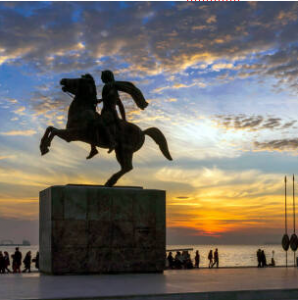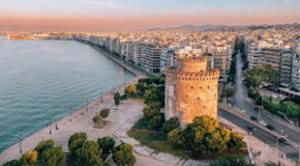
BY MICHAEL TRIPOLITSIOTIS, C5
The metropolis of Thessaloniki has a population of over a million and is the biggest city in the northern part of Greece. It is built by Thermaïkos and Strymonikos Gulf, on fertile grounds resting beside the Rivers of Axios, Gallikos and Loudias, as well as the lakes Koroneia and Volvi.
 Thessaloniki is a busy, bustling city at all times of the day but especially at night when it becomes brighter and colourful.
Thessaloniki is a busy, bustling city at all times of the day but especially at night when it becomes brighter and colourful. Get to know another aspect of the city’s history by stopping at the Byzantine Baths, near Koule Kafe square. It is a rare sample of Byzantine Baths dating back to the end of the 13th century.
Get to know another aspect of the city’s history by stopping at the Byzantine Baths, near Koule Kafe square. It is a rare sample of Byzantine Baths dating back to the end of the 13th century.Moreover, the city of Thessaloniki is a renowned shopping destination; the main shopping streets are Tsimiski, Ermou, Egnatia, Mitropoleos and the environs. Make sure to pass by the old fashioned food markets of Modiano and Kapani (built in 1922). Enjoy your day out among the shops housed in the market’s arcades or sit and relax in one of the charming cafes and traditional eateries (mezedopolio)!
Another fascinating market to explore is the 15th c. Bezesteni Textile Market (Venizelou and Solomou St.) where you’ll find a sheer variety of fabrics in all colors and designs.
Jaunt around Thessaloniki’s port where the customs and warehouse buildings (built in 1910) are home to the Photography and Cinema Museums but are also used as venues for the International Film Festival.
Last but not least, don’t miss the nearby Ladadika neighbourhood, the best place to soak up the vibrant nightlife scene in Thessaloniki near Aristotelous square. This is where you’ll enjoy the night out in restaurants and nightclubs in old restored buildings that were saved by the 1917 fires.
More things to see:
- the Y.M.C.A.’s stately building (greek abbreviation Χ.Α.Ν.Θ.),
- the OTE tower from where you can enjoy a birds eye view of the city,
- the Holocaust memorial on Eleftherias Square, dedicated to the Greek Jews, executed by the Nazis (1942),
- the large number of churches and museums of the city will make your trip to Thessaloniki unforgettable!
Thessaloniki’s gastronomy
Α culinary paradise!
Thessaloniki’s cuisine is widely known for its quality and variety. As the formation of the overall culture of the city came under many influences, Thessaloniki’s cuisine is one of the richest in Greece. Traditional recipes as well as modern trends have created a wide range of choices.
Professionals in Thessaloniki are renowned for their courtesy and hospitality. Whether one chooses a restaurant with many stars or a traditional little taverna, or whether one wants a snack whilst enjoying a walk, they are sure to be completely satisfied. Tavernas, both large and small, whether in the city centre or in the surrounding districts, offer incomparable delights. Traditional, authentic flavours from Pontus, Asia Minor, Constantinople, excite the senses. Arab and Armenian corners enhance the culinary map with unusual tastes.
 The city’s many restaurants create original tastes against the canvas of Mediterranean cuisine. Excellent fish and seafood dishes are accompanied by the strongly-flavoured Macedonian wines. Succulent salads and imaginative desserts complete a perfect meal.
The city’s many restaurants create original tastes against the canvas of Mediterranean cuisine. Excellent fish and seafood dishes are accompanied by the strongly-flavoured Macedonian wines. Succulent salads and imaginative desserts complete a perfect meal.
The small shops selling pies, the famous Thessaloniki cream-filled bougatsas, are very popular. Nobody can resist these sweet and savoury provocations. The famous Trigona Panoramatos, custard cream filled pastries, have become Thessaloniki’s trademark. Special reference must be made to tripe and the restaurants that cleverly prepare it. A healthful dish, it helps to moderate the effects of staying up all night. So every night, and particularly at weekends, tripe-lovers finish up at one of the specialized restaurants. It is a ritualistic habit into which the people of Thessaloniki love to initiate travellers.
Corners full of tastes and aromas
One does not need to strive to find a good taverna or restaurant in Thessaloniki. Throughout the city there are plenty of areas well known as hubs of taste and recreation. Let us introduce you to two of those:
Modiano market – the Paris of Thessaloniki
The market takes its name from the inspired architect Eli Modiano. It was built in 1922, with obvious architectural references to the corresponding covered markets in Paris. It lies within the block bordered by Aristotelous, Ermou, Komninon and Vasileos Irakleiou Streets. It is a complex of five arcades with a pedimented facade and a glass roof. It houses small shops selling mainly food, as well as ouzeries offering countless tastes.
There is probably no description that can portray the colour, the stunned feeling that time has stopped dead and the quaintness of this ‘world’ that is the Modiano market. It must be noted that whilst it is a working market where one can find fish, meat, fresh vegetables and fruit, spices and herbs, it is included in tourist guides as one of Thessaloniki’s sights. This is the heart of the old city which though is still beating strongly.
Ladadika – eternal Thessaloniki
The Ladadika quarter was one of the most important commercial districts in Thessaloniki. For many decades the quarter housed food stores mainly selling wholesale goods. The area was unharmed by the famous fire of 1917. It resembles a small state within the city with a Byzantine stamp. Small, cobbled alleys, mysterious dead-end streets and charming facades make up one of the most picturesque neighbourhoods in the city.
The area was restored at the end of the 1970s. The old shops were turned into tavernas, restaurants and bars. Every night the quarter is inundated with people who love good food and the feel of old Thessaloniki.
FUN FACT
King Philip II of Macedonia , to celebrate his daughter’s birthday, which coincided with the victory of his troops in 353 BC, between the Macedonian army and the Thessalian Alliance at the important battle of Crocius Field in Thessaly against the Phocians , he is said to have named his newborn daughter «Thessalonica» , from Thessalon + Niki.
ΘΕΣΣΑΛΟΝΙΚΗ: Η Αρχόντισσα του Βορρά
ΓΡΑΦΕΙ Ο ΜΙΧΑΗΛ ΤΡΙΠΟΛΙΤΣΙΩΤΗΗΣ, Γ5
Η Θεσσαλονίκη μια μεγάλη πόλη, με πάνω από 1 εκατ. κατοίκους, είναι το μεγαλύτερο αστικό κέντρο της Βόρειας Ελλάδας. Βρίσκεται στην εύφορη γη που αναπτύσσεται γύρω από τα ποτάμια Αξιό, Γαλλικό και Λουδία, τις λίμνες Κορώνεια και Βόλβη, αλλά και τις θάλασσες του Θερμαϊκού και του Στρυμονικού Κόλπου.
Κατοικείται από τα προϊστορικά χρόνια και στην περιοχή υπάρχουν ίχνη ζωής από εκείνη την εποχή. Το σύγχρονο ωστόσο στοιχείο της πόλης αναμειγνύεται αρμονικά με την ιστορία, όπως αυτή αποτυπώνεται στους αρχαιολογικούς χώρους, στις βυζαντινές της εκκλησίες και στα ενδιαφέροντα μνημεία της, διαφορετικών περιόδων που σώζονται σήμερα στην πόλη σε μια σπάνια και γοητευτική συνύπαρξη και αποτυπώνουν με τον εμφατικότερο τρόπο αυτή τη διαχρονικά πολυπολιτισμική και κοσμοπολίτικη φυσιογνωμία της.
Ξεκινήστε τη βόλτα σας παραλιακά από το σύμβολο της πόλης που δεν είναι άλλο από το Λευκό Πύργο που φιλοξενεί στο εσωτερικό του, έκθεση για την ιστορία της Θεσσαλονίκης από την ίδρυσή της ως το 1922 καθώς και θαυμάσιες συλλογές που αφορούν την βυζαντινή ιστορία της πόλης. Ο οχυρωματικός κυλινδρικός πύργος με ύψος 33,9 μ. και διάμετρο 22,7 μ,. που χτίστηκε επί Σουλεϊμάν Β΄ του Μεγαλοπρεπούς περίπου στα τέλη του 15ου αι., αποτελούσε μέρος της παραλιακής οχύρωσης της πόλης, ενώ αργότερα χρησιμοποιήθηκε από τους Οθωμανούς ως τόπος εκτελέσεων (ονομαζόταν Κανλί Καστέλι, που σημαίνει «πύργος του αίματος»). Τη σημερινή ονομασία του την πήρε τον 19ο αι.
Στην πλατεία του Πύργου, επισκεφθείτε επίσης το Βασιλικό Θέατρο, κτίσμα του 1940, το οποίο αποτελεί την έδρα του Κρατικού Θεάτρου Βορείου Ελλάδος. Το τριώροφο ανακαινισμένο κτίριο, επιφάνειας 11.000 τ.μ., διαθέτει πολυτελείς αίθουσες και μια από τις πιο σύγχρονες σκηνές της Ευρώπης.
Έπειτα κατευθυνθείτε στην πλατεία Αριστοτέλους, την κεντρικότερη πλατεία της πόλης με μνημειακά μέγαρα, που σχεδιάστηκε από την επιτροπή Έρμπαρ, μετά την καταστροφική πυρκαγιά του 1917. Πρόκειται για μία από τις μεγαλύτερες και εντυπωσιακότερες πλατείες στην Ελλάδα με θέα στον Θερμαϊκό κόλπο! Όταν η ατμόσφαιρα είναι διαυγής διακρίνεται ο ορεινός όγκος του Ολύμπου. Περπατήστε επίσης στην παραλιακή λεωφόρο Νίκης (παλιά παραλία) που εκτείνεται από το λιμάνι της πόλης (στα Δ) ως το άγαλμα του Μεγάλου Αλεξάνδρου (στα Α), με πολλά καφέ, μπαρ και καταστήματα. Αποτελεί έναν από τους πλέον προσφιλείς περιπάτους των κατοίκων και των επισκεπτών.
Μια στάση που πρέπει να κάνετε στη βόλτα σας είναι στο ανακτορικό συγκρότημα του Γαλερίου. Περιλαμβάνει το Οκτάγωνο (προοριζόταν για αίθουσα θρόνου) με τα περίφημα ψηφιδωτά, το Νυμφαίο, την αψίδα του Γαλερίου, γνωστή ως Καμάρα, η οποία χτίστηκε το 305 μ.Χ., και την επιβλητική Ροτόντα, το κυκλικό θολοσκέπαστο κτίσμα με τα εντυπωσιακά παλαιοχριστιανικά ψηφιδωτά (τέλη 4ου αι.)
Γνωρίστε μια πολύ ενδιαφέρουσα περίοδο της ιστορίας της πόλης με μια επίσκεψή σας στην Αρχαία Αγορά, που λειτούργησε από τον 3ο αι. π.Χ. έως και τον 5ο αι. μ.Χ. Έχουν αποκαλυφθεί η αγορά της πόλης, το νομισματοκοπείο, το ωδείο, μια αίθουσα που μοιάζει να αποτελούσε το αρχείο της πόλης, τμήμα του βαλανείου, με λουτρά, ταβέρνα και πορνείο, καθώς και πολλά κινητά ευρήματα. Επίσης στην οδό Γ΄ Σεπτεμβρίου, κάτω από την οποία αποκαλύφθηκε αρχαίος ναός και παλαιοχριστιανικοί τάφοι (4ος-7ος αι.).
Μια άλλη πτυχή της ιστορίας της πόλης θα γνωρίσετε κάνοντας μια στάση στο Βυζαντινό Λουτρό, κοντά στην πλατεία Κουλέ Καφέ. Χρονολογείται στα τέλη του 13ου αι. και αποτελεί ένα από τα σπανιότατα δείγματα βυζαντινών λουτρών.
Επισκεφθείτε ακόμα το Ισάκ Πασά Τζαμί (1484), κοντά στην οδό Κασσάνδρου, και το Χαμτζά Μπέη Τζαμί (1467). Το τελευταίο καταστράφηκε από σεισμό και ξαναχτίστηκε το 1620. Βρίσκεται στη συμβολή των οδών Εγνατίας και Βενιζέλου. Επίσης, μην παραλείψετε να δείτε το Μπέη Χαμάμ (1444), την Εγνατία οδό, το Πασά Χαμάμ (1520), το Παζάρ και το Γενί Χαμάμ.
Η Θεσσαλονίκη, όμως, φημίζεται και για την αγορά της. Οι κεντρικοί δρόμοι για ψώνια είναι η Τσιμισκή, η Ερμού, η Εγνατία και η Μητροπόλεως με όλες τις κάθετες οδούς που τις διασταυρώνουν. «Αγορά», όμως, δεν σημαίνει μόνο ρούχα και αξεσουάρ. Η βόλτα στις στοές Μοδιάνο και Καπάνι (σκεπαστές αγορές) αποτελεί ευκαιρία για να γνωρίσετε τη Θεσσαλονίκη των περασμένων δεκαετιών. Εδώ ο χρόνος σταμάτησε και η παράδοση συνεχίζει να είναι βίωμα των σύγχρονων εμπόρων και των πελατών. Θεωρούνται οι κεντρικότερες αγορές της πόλης, καθώς συνδυάζουν την αφθονία, τις καλές τιμές και την ποικιλία. Η ομορφιά της περιπλάνησης συμπληρώνεται και από τα συμπαθητικά καφενεδάκια και μεζεδοπωλεία του ιστορικού κέντρου της πόλης, που φιλοξενούνται σε αυτές τις στοές.
Εάν αγαπάτε τα υφάσματα, μην παραλείψετε να κάνετε μια βόλτα στο Μπεζεστένι, στο κέντρο της αγοράς (Βενιζέλου και Σολωμού), όπου πωλούνταν πολυτελή υφάσματα. Είναι ένα ορθογώνιο κτίριο με τέσσερις εισόδους. Χτίστηκε στα τέλη του 15ου αι.
Αφιερώστε χρόνο για να εξερευνήσετε το λιμάνι της πόλης. Στο τελωνείο, και τις αποθήκες (1910), σήμερα πραγματοποιούνται εκδηλώσεις του Διεθνούς Φεστιβάλ Κινηματογράφου και στεγάζονται το Μουσείο Κινηματογράφου και το Μουσείο Φωτογραφίας.
Κατευθυνθείτε στα κοντινά Λαδάδικα, την ιστορική συνοικία κοντά στην πλατεία Αριστοτέλους που διασώθηκε από τη μεγάλη πυρκαγιά του 1917. Τα αναπαλαιωμένα κτίρια λειτουργούν ως εστιατόρια και νυχτερινά κέντρα.






